Human Orbital Spaceflights
![]()
International Flight No. 183Soyuz TM-23SkiphRussia |
 |
 |
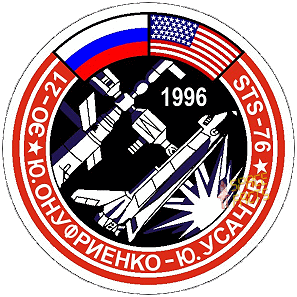 |
||
![]()
Launch, orbit and landing data
walkout photo |
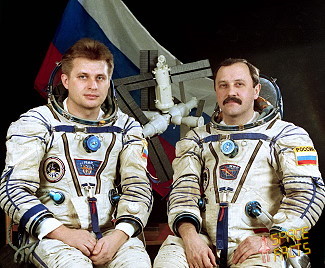 |
||||||||||||||||||||||
alternative crew photo |
|||||||||||||||||||||||
alternative crew photo |
Crew
| No. | Surname | Given names | Position | Flight No. | Duration | Orbits | |
| 1 | Onufriyenko | Yuri Ivanovich | Commander | 1 | 193d 19h 07m 35s | 3066 | |
| 2 | Usachyov | Yuri Vladimirovich | Flight Engineer | 2 | 193d 19h 07m 35s | 3066 |
Crew seating arrangement
|
 |
|
||||||||||||||||
Backup Crew
|
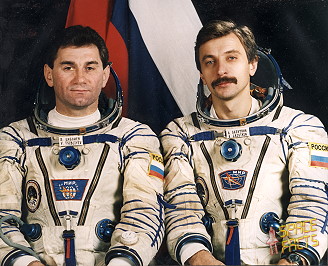 |
|||||||||||||||
alternative crew photo |
Hardware
| Launch vehicle: | Soyuz-U (No. W15000-651) |
| Spacecraft: | Soyuz TM-23 (7K-STM No. 72) |
Flight
|
Launch from the Baikonur Cosmodrome landing 98
km southwest of Akmola. Following a two-day solo flight Soyuz TM-23 docked with the Mir space station on February 23, 1996. Both cosmonauts became the 21st resident crew after the crew exchanging. Soyuz TM-22 landed on February 29, 1996 at 10:42 UTC. Yuri Onufriyenko and Yuri Usachyov performed the first EVA on March 15, 1996 (5h 51m). The cosmonauts installed the STRELA telescopic boom. The first Strela boom could only reach only Mir's -Z side, so a second Strela boom was installed to allow the cosmonauts to translate easily to the repositioned Kristall module. The astronauts attached the boom to brackets on the Mir core and extended it to its full 12-m (39.3-ft) length, then used it to return to the Kvant2 SALC. Space Shuttle STS-76 docked with Mir space station on March 24, 1996. The flight was the third Shuttle mission to dock with the Russian space station Mir, as part of the Shuttle-Mir Program, carrying astronaut Shannon Lucid to the orbital laboratory. She remained aboard the orbiting station and joined as Research Cosmonaut the 21st Mir resident crew until Atlantis again docks to Mir in early September 1996 (STS-79). During the common flight of STS-76 and Mir Linda Godwin and Michael Clifford performed an EVA on March 27, 1996 (6h 02m) to attach the Mir Environmental Effects Payload (MEEP), including 4 different experiments, onto handrails located on the Mir Docking Module. The spacewalk was the first ever performed from the docked Space Shuttle and Mir complex. The Simplified Aid For EVA Rescue (SAFER), first test-flown on shuttle mission STS-64 in September 1994, were worn by Linda Godwin and Michael Clifford and were used only for a contingency. Spacewalking equipment to be evaluated consisted of several new tether designs with hooks that can be attached to both space shuttle handrails and to Mir space station handrails. Normal space shuttle tether hooks are not large enough to be connected to the Mir handrails. A U.S. camera mounted on the exterior of the Mir docking module, used during STS-74 to align the module as it was permanently docked to the Mir, also were removed by the spacewalkers and returned to Earth for reuse. Prior to beginning the spacewalk, the hatches of both Atlantis and the Mir were closed at the docking mechanism. A hatch at the end of the shuttle tunnel adapter also was closed, allowing only the airlock and tunnel to be depressurized. All of the shuttle crew members were in Atlantis' crew cabin for the duration of the spacewalk, and all Mir crew members, including Mir-21 crewmember Shannon Lucid, were aboard the Mir. Linda Godwin and Michael Clifford removed the four MEEP experiment containers from their stowed positions along the right and left sides of Atlantis' cargo bay. Each experiment container was attached to handrails on the exterior of the docking module using special clamps installed by Linda Godwin and Michael Clifford. After each experiment package was clamped to the appropriate module handrails, the spacewalkers unfolded the packages to expose the experiment panels. The tools evaluated were called Common US/Russian EVA tools and included safety tethers with larger hooks to allow attachment to the Mir's exterior handrails and a new foot restraint also designed to allow attachment to the Mir fixtures. To remove the Docking Module television camera, the spacewalkers used cable cutters to sever the cable connecting the camera and then turned a knob that released the camera's mounting. The camera was tethered and taken aboard Atlantis. During five days of docked operations, about 1,500 pounds (680 kilograms) of water and two tons of scientific equipment, logistical material and resupply items transferred to Mir; experiment samples and miscellaneous equipment brought over to orbiter. In Biorack, 11 separate scientific investigations were conducted. Study topics included effect of microgravity and cosmic radiation on plants, tissues, cells, bacteria and insects and effects of microgravity on bone loss. Also transferred to station were Mir Glovebox Stowage (MGBX) equipment to replenish glovebox already on station; Queen's University Experiment in Liquid Diffusion (QUELD) flown in orbiter middeck locker; and High Temperature Liquid Phase Sintering (LPS) experiment. Payload bay configuration included Orbiter Docking System in forward area and SPACEHAB single module toward the aft. STS-76 began a series of Shuttle-Mir missions that carried a SPACEHAB module onboard. Over the course of these missions, SPACEHAB modules carried a mix of supplies and scientific equipment to and from Mir. On STS-76, the SPACEHAB module was in a single module configuration, similar to previous SPACEHAB missions. In addition to the Spacelab short tunnel and airlock which have flown on SPACEHAB single module missions before, there was an extended tunnel beyond the airlock and a 19-inch (48 centimeters) tunnel extension built by SPACEHAB, Inc. to position the SPACEHAB module in the optimal point in the Shuttle's cargo bay. Because the single module was positioned further aft than on previous missions, the module will be able to carry up to 4,800 pounds (2,177 kg) of useable payload up to and back from Mir. Equipment that was carried in the SPACEHAB module on STS-76 can be categorized in the following five types: Russian Logistics: A double rack was dedicated to some of the Russian logistics, including the gyrodyne and the individual equipment and seat liner (IESL) kit. The gyrodyne was transferred by the crew to and from Mir to replace a used gyrodyne. The IESL kit was transferred by the crew to Mir to be available for use by Shannon Lucid in case of an emergency return to Earth in a Soyuz capsule. Three Russian storage batteries which were returned to Earth from Mir on STS-71 were mounted on the aft bulkhead of the SPACEHAB module. During docked operations, the crew removed the batteries and transferred them to Mir. Numerous Russian logistics items totaling approximately 1,900 lbs. (861 kg) were carried in the SPACEHAB soft stowage system. Items included food and water containers, clothing and sleeping articles, personal hygiene equipment, a current transformer, and a Mir supplemental kit. These items were transferred to Mir by the crew. EVA Tools: Several soft bags were used to carry EVA support equipment. The equipment included Waist Tethers, Push Lock Tether Tools and a 35 mm Camera and Accessories (Tools for 96 Bolts). Other Detailed Science Objectives (DSOs) also were supported by the EVA equipment. ISS Risk Mitigation Experiments (RME): The Risk Mitigation Experiments hardware was carried in soft stowage bags and consisted of the following items: Mir Electric Field Characterization (MEFC) hardware, and the Mir Environmental Effects Payload (MEEP) attachment brackets. The MEFC experiment will collect data on the internal and external radio interference in the 400 MHz to 18 GHz frequency band. The hardware consisted of a radio frequency spectrum analyzer and power cable, an orbiter window antenna, and a payload general support computer. The experiment hardware was removed from the SPACEHAB module. Experiment operations were performed on the shuttle's flight deck then returned to the module for return to Earth. The MEEP experiment was designed to collect samples of orbital and micrometeoroid debris and will be attached to Mir during an EVA by the crew. The MEEP attachment brackets will be clamped to external handrails on Mir and will remain there after their installation during the mission. American Logistics: About 15 full water bags supplied through the shuttle's water system were transferred to Mir. New film also was swapped for film already shot aboard Mir, and the docking module light and television camera was returned to Earth. Biorack: The European Space Agency's Biorack experiment shared a double rack with the Life Sciences Laboratory Equipment Refrigerator/Freezer (LSLE) in the SPACEHAB module. The Biorack was a multi-purpose facility designed to enable biological investigations on plants, tissues, cells, bacteria, and insects during spaceflight. Its main purpose was to investigate the effects of microgravity and cosmic radiation, particularly the effects of high-energy (HZE) particles, on the development of these species. Eleven experiments were conducted during the mission: three from the U.S., three from France, three from Germany, one from Switzerland and one from the Netherlands. The Life Sciences Laboratory Equipment Refrigerator/Freezer (LSLE R/F) was a vapor compression refrigerator which was carried in a double rack (with the Biorack) in the SPACEHAB module. The LSLE R/F has flown five times on board the Shuttle. Its internal volume was 2.5 ft 3 in. (80 centimeters), and could accept a variety of racks, shelves and containers, and maintains internal temperatures ranging from +10 degrees C to -22 degrees C. On STS-76, the LSLE R/F carried processed samples from the Biorack as well as the Johnson Space Center Frozen Stowage experiment which included blood, urine and saliva samples from the Mir-21 crew. These samples were analyzed on Earth for evidence of accelerated renal stone development and protein metabolism in microgravity. The Mir Glovebox Stowage (MGBX) was carried in soft stowage bags to replenish hardware for the MGBX located on Mir. Equipment included in the MGBX includes the Combustion Experiments Parts Box to be used with the candle flames in microgravity experiment and the Forced Flow Flamespread Test, the Passive Accelerometer, the Protein Crystal Growth Experiment, and the Protein Crystal Growth Thermal Enclosure System Ancillary. STS-76 undocked from Mir on March 29, 1996. The Priroda module blasted off from Baikonur on April 23, 1996 at 11.48.50 UTC, so 7 seconds later than planned. After an automatic approach guided by the system Kurs Priroda linked up with Mir complex on April 26, 1996 at 1243 UTC. It was quite an achievement to aim and dock a mass of 20 tons (like a huge locomotive) with a precision of less than millimeters. Priroda could take a breath for a while at the forward axial docking port of the transition section There were no intentions to switch over to the manual remote-control TORU. At 12:35:30 UTC Yuri Onufriyenko reported that Priroda was hovering for a while in a distance of 182 meters and that all was going well. From that distance Priroda started the final stage of the approach and flawlessly docked with Mir. Priroda remained electrically autonomous until the accomplishment of the repositioning to the +Z axis. A part of the cargo of Priroda consisted of biological experiments for the production of clean medical preparations and 900 kg equipment and experiments for the American astronaut Shannon Lucid. Priroda has been equipped by a lot of equipment for scientific research of the earth (all kinds of devices and camera's for remote sensing) and the atmosphere. On April 27, 1996 Priroda was redocked from the -X to the +Z axis. This operation began at 08:30 UTC and lasted two hours. The cosmonauts finished the air seal checks and opened the hatches. The cosmonauts also took air samples of the atmosphere inside Priroda for analyzes. Priroda ("Nature") was the last of the Mir modules, and completed Mir's orbital construction efforts started ten years prior to its launch. It had a mass of 19.7 tons, a length of 9.7 m, and a maximum diameter of 4.35 m. The module's primary purpose was Earth remote sensing. The mission's internationally provided experiments supported a six-point research program for determination of the atmosphere-ocean system characteristics, measurements of the land local characteristics, measurements of optical characteristics of the atmosphere, investigation of the sea surface roughness state, comparison of radiation and reflection characteristics of the sea surface in the microwave range, and measurements of the concentrations of trace gases in the atmosphere. Specific remote sensing objectives included measurements of ocean surface temperatures to within 0.5 deg K, measurements of surface wind velocities to within 1 m/s and +/-20 deg., atmospheric temperature profile to within 3K, sea wave height measurements to within 20 cm, and cloud temperature measurements to within 1K. The vehicle also supported materials science, space technology, biotechnology and life sciences studies. The module had a total pressurized volume of 66 cubic meters. The module did not carry any solar arrays and had to rely on its internal battery system when not attached to the station. 2 3.9 kN main engines and 400N attitude control thrusters were used during the initial docking process. The scientific payload consisted of: Ainur electrophoresis unit; Korund 1MP semiconductor unit; Ikar N nadir microwave radiometers - 0.3, 0.8, 1.35, 2.25 6.0 micrometer wavelengths, resolution up to 60km and 0.15 deg. K; Ikar D scanning mirowave radiometer system - scans 40 deg off track with a 400 km swath. 4.0, 0.3, 0.8, 1.35 micrometer wavelengths, resolution up to 5 km and 0.15 deg. K; Ikar P panoramic microwave radiometers - 2.25, 6.0 micrometer wavelengths, 750 km swath, resolution up to 75 km and 0.15 deg. K; Istok 1 IR spectro-radiometer - wavelengths between 4.0-16.0 micrometer, 7 km swath, 0.7x2.8 km resolution; Ozon M spectrometer - used for ozone/aerosol profiles. 160 channels between 0.257-1.155 micrometer, 1 km altitude resolution; Travers Synthetic Aperture Radar - 1.28/3.28 GHz, 50 km swath, 38 deg. look angle, 50 m resolution; Alissa lidar - measures cloud height, structure, optical properties, 150 m vertical resolution, 1 km horizontal resolution; MOS-Obzor spectrometer - measures aerosol profile and ocean reflectance, 17 channels between 0.750-1.01 micrometer, 80 km swath, 700 m resolution; MSU-E2 high-resolution optical scanner - 10 m resolution, 3 channels between 0.5 and 0.9 micrometer, nadir viewing, 2 x 24.5 km swaths; DOPI interferometer - studies gases and aerosols. 2.4-20 micrometer; Greben ocean altimeter - 10 cm resolution, 13.76 GHz, 2.5 km swath, nadir viewing; Centaur 400 MHz receiver - used to gather ocean buoy data; MOMS 02P Earth imager - 4 channels between 0.440-0.810 micrometer. Multi spectral, stereo or high resolution data, 6 km resolution. The launch of Progress M-31 has been put forward to May 05, 1996 at 07:04 UTC. The unmanned resupply vessel to Mir delivered 1,140 kg of fuel and 1,700 kg of cargo to the Mir complex. It docked with Mir on May 07, 1996 at 08:54:19 UTC, undocked on August 01, 1996 at 16:44:54 UTC and was destroyed in reentry over the Pacific on August 01, 1996 at 20:33:03 UTC. The cargo had a mass of 2410 kg and consisted of the normal cargo delivered by Progresses: water, fuel, letters, equipment, repair material etc. Yuri Onufriyenko and Yuri Usachyov performed the second spacewalk on May 20, 1996 (5h 20m). During the EVA all went well and that what the crew had to do has been accomplished for 100 %. The crew transferred a solar battery from the outside of the docking compartment (SO) to the Kvant1 (Module-E). For their work the cosmonauts used the Strela girder. The cosmonauts secured MCSA to Strela, then moved it to Kvant1, removed it from its container, and attached it to a mounting bracket. The cosmonauts returned to the Kvant2 airlock using Strela and assembled a 1.2-m (3.9-ft) Pepsi can replica from aluminum struts and nylon sheets. The oversized replica was delivered by Progress M-31. They videotaped each other near the replica, then disassembled it for return to Earth. The videotape would be used by Pepsi Cola in a commercial campaign. Shannon Lucid assisted the cosmonauts during the putting on and off of their spacesuits. During the EVA she took care for the systems of the space station and the communications. The third EVA by Yuri Onufriyenko and Yuri Usachyov occurred on May 24, 1996 (5h 43m). The cosmonauts deployed the 18-m-long (59-ft-long) MCSA outside the Kvant1 module using a handcrank. The array, which unfolded like an accordion, had 84 "panel modules" of 80 silicon solar cells each. The cells were identical to those planned for use on the U.S. segment of the International Space Station. The cosmonauts linked the array to Mir's power supply, but the electrical cables used permitted power to be supplied from only half of the array. Fully operational, MCSA would supply 6 kW of electricity - at the end of this EVA, it supplied half that. A Progress-M supply ship would deliver new cables for installation on a future spacewalk. Yuri Onufriyenko and Yuri Usachyov conducted the fourth spacewalk on May 30, 1996 (4h 20m). The Modular Optoelectrical Multispectral Scanner (MOMS) device was launched inside Priroda for later EVA installation. MOMS flew on the STS-7 and STS-41B Shuttle missions. Prior to the EVA, the cosmonauts planned their activities and positioned equipment in the airlock, then gathered together tools and placed them in their tool tray. To prepare for the EVA, which was scheduled for the middle of the night, the crew slept in, ate lunch, then slept again. Before entering the airlock, Yuri Onufriyenko placed a piece of red tape across controls Shannon Lucid was not to touch. While in the airlock he and Yuri Usachyov asked her about station air pressure levels and the location of the complex over the Earth. Shannon Lucid found the EVA difficult to observe through Mir's few tiny ports. Radio communication with the EVA crew was excellent, Shannon Lucid reported, but there was little communication with the TsUP. The cosmonauts attached the MOMS to its site on Priroda's exterior. The cosmonauts referred to the male and female electrical connectors as "mamas" and "papas," which Shannon Lucid said made Mir feel "warm and homey." The fifth EVA was performed by Yuri Onufriyenko and Yuri Usachyov on June 06, 1996 (3h 34m). At the outer surface of the Module Spektr they replaced a cassette of the KOMZA-experiment (a Swiss experiment for the study of inert interstellar gasses) and at the outside of Module-D (Kvant2) they installed some detectors for space dust and space debris: an American instrument and the SKK-11, a Russian made device. The EVA lasted 1 hour longer than had been planned. Yuri Onufriyenko and Yuri Usachyov needed for their work and movements considerably more time than had been foreseen in the so called cyclogram for this EVA. The EVA cosmonauts gave instructions to Shannon Lucid who was on duty inside the complex and observed the EVA through portholes. The sixth and final spacewalk was again performed by Yuri Onufriyenko and Yuri Usachyov on June 13, 1996 (5h 42m). They had to accomplish some very strenuous tasks: the installation and deployment of the Ferma-3 girder construction at the outer surface of the Kvant1 module and the repair of the Travers antenna (the huge SAR antenna on the module Priroda). They deployed the 4 sections of the Ferma-structure until the desired length of 5 meters. The Travers radio locator antenna had not been fully deployed by commands from inside the module Priroda and so Yuri Onufriyenko and Yuri Usachyov completed this manually during their EVA. The Travers was then operational. The cosmonauts closed out the last EVA by filming the final segment of the Pepsi commercial. After this work they made their way back to the airlock of Kvant2. This was not easy and went slowly. Back on board the cosmonauts quickly recovered and expressed their satisfaction about the accomplished tasks but also about the assistance they got from Shannon Lucid being on command inside the complex. She had been busy with camerawork and used all available films and cassettes. The launch of Progress M-32 has been put back several times. The Progress M-32 had to deliver new supplies of water, fuel, oxygen, food, etc. to the Mir space station. The reasons for the delays are two failures with the Soyuz-U rocket, which also is used for the launches of Progress-M ships. This freighter was launched from Baikonur on July 31, 1996 at 20:00:06 UTC. Progress M-32 docked at the Mir station (-X axis, forward port transition section) on August 02, 1996 at 22:03:44 UTC. Approach and docking were executed in the automatic mode by the use of the system Kurs. Protein crystal growth experiments were done. More experiments in materials science using high temperature melting oven "Optizon". Other experiments were Visual Earth Observation and medical research. The Soyuz TM-24 was launched with the carrier Soyuz-U from Baikonur on August 17, 1996 at 13:18:03 UTC. Soyuz TM-24 reached the planned orbit without problems and all systems worked well. It docked at Mir on August 19, 1996 at 14.50.23 UTC. Approach and docking took place in the automatic mode with the system Kurs. The Soyuz spacecraft is composed of three elements attached end-to-end - the Orbital Module, the Descent Module and the Instrumentation/Propulsion Module. The crew occupied the central element, the Descent Module. The other two modules are jettisoned prior to re-entry. They burn up in the atmosphere, so only the Descent Module returned to Earth. The deorbit burn lasted about 240 seconds. Having shed two-thirds of its mass, the Soyuz reached Entry Interface - a point 400,000 feet (121.9 kilometers) above the Earth, where friction due to the thickening atmosphere began to heat its outer surfaces. With only 23 minutes left before it lands on the grassy plains of central Asia, attention in the module turned to slowing its rate of descent. Eight minutes later, the spacecraft was streaking through the sky at a rate of 755 feet (230 meters) per second. Before it touched down, its speed slowed to only 5 feet (1.5 meter) per second, and it lands at an even lower speed than that. Several onboard features ensure that the vehicle and crew land safely and in relative comfort. Four parachutes, deployed 15 minutes before landing, dramatically slowed the vehicle's rate of descent. Two pilot parachutes were the first to be released, and a drogue chute attached to the second one followed immediately after. The drogue, measuring 24 square meters (258 square feet) in area, slowed the rate of descent from 755 feet (230 meters) per second to 262 feet (80 meters) per second. The main parachute was the last to emerge. It is the largest chute, with a surface area of 10,764 square feet (1,000 square meters). Its harnesses shifted the vehicle's attitude to a 30-degree angle relative to the ground, dissipating heat, and then shifted it again to a straight vertical descent prior to landing. The main chute slowed the Soyuz to a descent rate of only 24 feet (7.3 meters) per second, which is still too fast for a comfortable landing. One second before touchdown, two sets of three small engines on the bottom of the vehicle fired, slowing the vehicle to soften the landing. Soyuz TM-23 undocked on September 02, 1996 at 04:20 UTC, and made a small separation burn at 04:24:40 UTC. The deorbit burn was at 06:47:20 UTC. The three modules separated at 07:14:36 UTC and the parachute deployed at 07:26 UTC. The landing was at 07:41:40 UTC, 107 km SW of Akmola in Kazhakstan with Yuri Onufriyenko, Yuri Usachyov and Claudie André-Deshays aboard. |
EVA data
| Name | Start | End | Duration | Mission | Airlock | Suit | |
| EVA | Usachyov, Yuri | 15.03.1996, 01:04 UTC | 15.03.1996, 06:55 UTC | 5h 51m | Soyuz TM-23 | Mir - Kvant2 | Orlan-DMA No. 26 |
| EVA | Onufriyenko, Yuri | 15.03.1996, 01:04 UTC | 15.03.1996, 06:55 UTC | 5h 51m | Soyuz TM-23 | Mir - Kvant2 | Orlan-DMA No. 25 |
| EVA | Godwin, Linda | 27.03.1996, 06:36 UTC | 27.03.1996, 12:38 UTC | 6h 02m | STS-76 | Atlantis - Mir | EMU No. 2039 |
| EVA | Clifford, Michael | 27.03.1996, 06:36 UTC | 27.03.1996, 12:38 UTC | 6h 02m | STS-76 | Atlantis - Mir | EMU No. 2044 |
| EVA | Usachyov, Yuri | 20.05.1996, 22:50 UTC | 21.05.1996, 04:10 UTC | 5h 20m | Soyuz TM-23 | Mir - Kvant2 | Orlan-DMA No. 26 |
| EVA | Onufriyenko, Yuri | 20.05.1996, 22:50 UTC | 21.05.1996, 04:10 UTC | 5h 20m | Soyuz TM-23 | Mir - Kvant2 | Orlan-DMA No. 25 |
| EVA | Usachyov, Yuri | 24.05.1996, 20:47 UTC | 25.05.1996, 02:30 UTC | 5h 43m | Soyuz TM-23 | Mir - Kvant2 | Orlan-DMA No. 26 |
| EVA | Onufriyenko, Yuri | 24.05.1996, 20:47 UTC | 25.05.1996, 03:30 UTC | 5h 43m | Soyuz TM-23 | Mir - Kvant2 | Orlan-DMA No. 25 |
| EVA | Usachyov, Yuri | 30.05.1996, 18:20 UTC | 30.05.1996, 22:40 UTC | 4h 20m | Soyuz TM-23 | Mir - Kvant2 | Orlan-DMA No. 26 |
| EVA | Onufriyenko, Yuri | 30.05.1996, 18:20 UTC | 30.05.1996, 22:40 UTC | 4h 20m | Soyuz TM-23 | Mir - Kvant2 | Orlan-DMA No. 25 |
| EVA | Usachyov, Yuri | 06.06.1996, 16:56 UTC | 06.06.1996, 20:30 UTC | 3h 34m | Soyuz TM-23 | Mir - Kvant2 | Orlan-DMA No. 26 |
| EVA | Onufriyenko, Yuri | 06.06.1996, 16:56 UTC | 06.06.1996, 20:30 UTC | 3h 34m | Soyuz TM-23 | Mir - Kvant2 | Orlan-DMA No. 25 |
| EVA | Usachyov, Yuri | 13.06.1996, 12:45 UTC | 13.06.1996, 18:27 UTC | 5h 42m | Soyuz TM-23 | Mir - Kvant2 | Orlan-DMA No. 26 |
| EVA | Onufriyenko, Yuri | 13.06.1996, 12:45 UTC | 13.06.1996, 18:27 UTC | 5h 42m | Soyuz TM-23 | Mir - Kvant2 | Orlan-DMA No. 25 |
Photos / Graphics
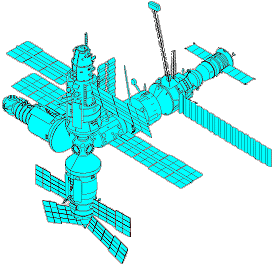 |
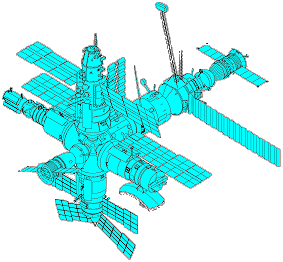 |
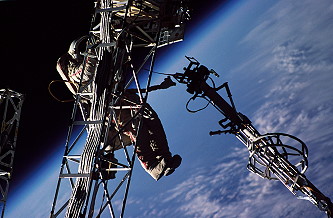 |
 |
 |
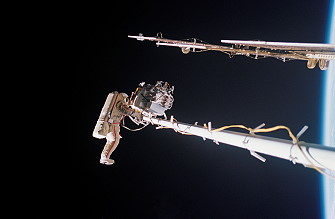 |
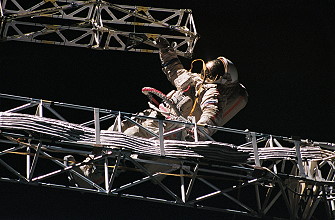 |
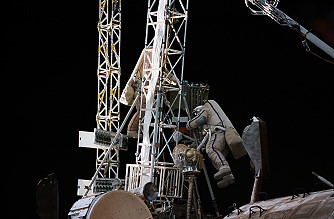 |
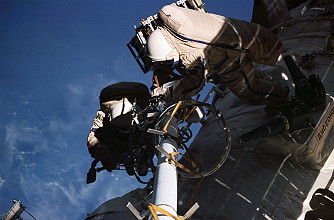 |
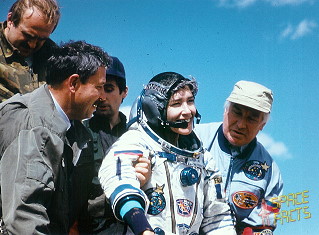 |
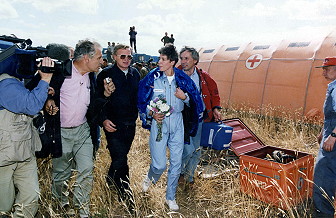 |
| © |  |
Last update on April 30, 2023.  |
 |